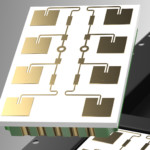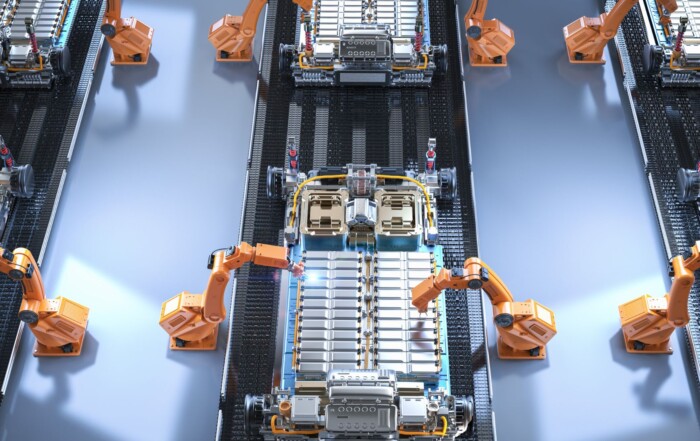Radar off the roll –
Sensor technology for high-volume electronics production.
Smaller, faster, and high-quantity – industry is imposing increasingly stringent requirements when it comes to components’ design, ability to be processed, and performance. Demand for electronics is also rising more and more. Nowadays, simple everyday objects are increasingly being equipped with technical functions. And integrated sensors are by no means the exception anymore. Kitchen appliances, toys, and toilet flushes utilise sensor technology for automation and recording the environment.
However, in order to meet the growing the needs and demand on the part of industry and the consumer market, production processes and product design must be optimised. Efficient, automated manufacturing methods and advances in design are yielding a huge increase in production capacity.
For example, equipment manufacturers are relying on the miniaturisation of electronic components, resulting in maximum performance with minimum size. Manufacturers are integrating technical functions into extremely small end products in a space-saving manner. Through this development, it is now normal to wear a computer in the form of a wristwatch. Electronic components have become so tiny that they are usually assembled and manufactured by means of automated placement methods to help assure quality and accelerate production.
Today, modern factory plants are equipped with highly efficient machine lines for fully automated production. The proportion of assembly work performed manually has dropped and is usually limited to final assembly, touch-ups, testing, or complex work steps in the production process that machines cannot yet handle.
SMT placement
One production process developed for this purpose is surface-mount technology (SMT). Another term frequently heard in the context of this method is surface-mount devices (SDM). SMT is a fully automated placement process in which the components are designed such that they can be mounted and soldered directly on the surface of the printed circuit board.
This method was originally developed for calculators in order to reliably fit the miniaturised electronic components. But TVs and radios have also been getting smaller and smaller and rely on this same technology to enable their mass production.
The manufacturing process of surface mounting
SMT placement is used by factories for almost all electronic products and has now become indispensable in industry. Surface mountable devices – the components properly suited for surface mounting – have no wire connections like conventional components do. The technology is the counterpart to the automated through-hole technology (THT) mounting process, in which the components are wired on the back and soldered and connected by hand.
With SMT, no drilling is necessary in order to insert wiring. In this process, the printed circuit boards have connecting surfaces capable of being soldered. The soldering paste can be placed on them either via automated machine or through screen printing. The elements are then combined with the board using the melted solder, which subsequently cools down and hardens. One common method used is reflow soldering.
Finally, the components usually undergo a visual inspection procedure to identify component placement and manufacturing defects. Since small hairlines are hardly recognisable to the naked eye in small components, the manufacturers use the AOI image processing method.
Why SMT production prevails
The fully automated assembly process optimises production processes and enables electronic components to be processed efficiently. The process particularly boosts production quality when it comes to small components. Manufacturers who use this method save time and money: SMT placement assembly lines position the elements using pick & place technology, automatically correct positioning errors, and enable components to be placed on both sides of printed circuit boards.
The SMT production procedure ensures reduced waste and contamination. Sensitive EMI and HF components particularly benefit from the process, as this more protective method of manufacturing is less susceptible to errors.
The design of SMD components also contributes to enhancing their high-frequency functionality. The component spacing is smaller and the conducting paths shorter.
The process increases the stability of the components, since without wires they cannot subsequently detach (increased resistance to vibrations). In addition, the printed circuit boards can be fitted more densely with components. This enables manufacturers to achieve a significantly smaller electronic component design. The components are more lightweight, because thinner PCB material is used and there is no need for wires.
SMT radar sensors for greater production efficiency
Radar components suitable for surface mounting are not yet available. Sensors such as distance warning devices for cars were a rarity for a long time. Only a few top-class vehicles were available with the complex technology. The companies assembled, integrated, and aligned the sensors individually.
However, the added value that radar applications provide for road safety or automation applications has led to a sharp increase in demand. Since then, the market has seen rising demand for high-quality, large-scale production of assembly-friendly radar solutions for applications in various industries.
The radar experts from InnoSenT have therefore developed radar sensors suitable for surface mounting. For industry, the company launched the successful SMR product line already five years ago. ‘Surface Mountable Radars’ were the first radar front ends prepared for high-volume, industrial applications, since they are well-suited for SMT production.
They meet the stringent quality requirements, stand apart through their extremely small size and are available in large quantities. Customers can integrate the radars into their optimised SMT placement process to lower costs and save time.
In particular, applications involving mass sales, such as automatic lighting control, the area of building technology & energy management, security technology, and the contact-free and motion-controlled operation of technical devices are predestined for SMT-capable radar sensors. After all, the low cost sensors come on a roll and can be further processed efficiently, quickly, and in large quantities by automatic placement machines by means of the pick & place method.
Share this Content
InnoSenT’s product highlight: the SMR series
 InnoSenT’s SMR series includes various product variants for motion detection that have different modulations (CW and FMCW) and antennas but an identical structural design. This is because depending on the application, different radar functions or angles of vision are required. The SMR products were the first 24 GHz radar sensors in the world that could undergo further processing using SMT processes. InnoSenT supplies the components on tape & reel, and they are suitable for use with the pick & place method. They consume little power and are equipped with a low noise amplifier.
InnoSenT’s SMR series includes various product variants for motion detection that have different modulations (CW and FMCW) and antennas but an identical structural design. This is because depending on the application, different radar functions or angles of vision are required. The SMR products were the first 24 GHz radar sensors in the world that could undergo further processing using SMT processes. InnoSenT supplies the components on tape & reel, and they are suitable for use with the pick & place method. They consume little power and are equipped with a low noise amplifier.
Building Automation & Smart Home
Contactless and intelligent control for modern technology
Radar sensors take on many tasks for us, thus making our everyday lives easier, safer, and more efficient. They are a kind of sensory organ for objects for perceiving their surroundings. These technological assistants open up new possibilities for operating devices: contactless interaction between humans and devices. The sensors are the link for triggering or automating certain actions without contact or automating them.


